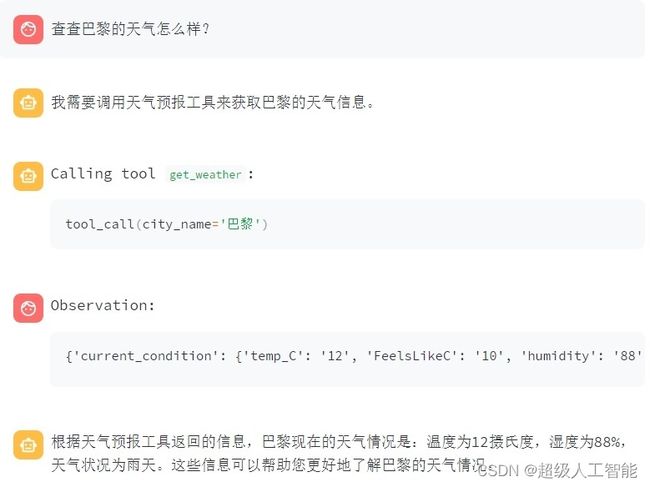ChatGLM3:打造更智能、更安全的代码解释器和工具使用体验
ChatGLM3 是由智谱AI训练的第三代大型语言模型,它不仅能理解和生成人类语言,还能执行代码、调用工具,并以 markdown 格式进行响应。为了提高用户体验,同时避免用户输入的注入攻击,ChatGLM3 采用了全新的对话格式。下载智谱清言体验ChatGLM3最新的能力。
ChatGLM3 对话格式
ChatGLM3 对话的格式由若干对话组成,其中每个对话包含对话头和内容。对话头占完整的一行,格式为 `<|role|>{metadata}`,其中 `<|role|>` 部分使用 special token 表示,无法从文本形式被 tokenizer 编码以防止注入。metadata 部分采用纯文本表示,为可选内容。
对话格式的角色包括:
- `<|system|>`:系统信息,设计上可穿插于对话中,但目前规定仅可以出现在开头
- `<|user|>`:用户,不会连续出现多个来自 `<|user|>` 的信息
- `<|assistant|>`:AI 助手,在出现之前必须有一个来自 `<|user|>` 的信息
- `<|observation|>`:外部的返回结果,必须在 `<|assistant|>` 的信息之后
使用场景
多轮对话
在多轮对话中,有且仅有 `<|user|>`、`<|assistant|>`、`<|system|>` 三种角色。例如:
<|system|>
You are ChatGLM3, a large language model trained by Zhipu.AI. Follow the user's instructions carefully. Respond using markdown.
<|user|>
Hello
<|assistant|>
Hello, I'm ChatGLM3. What can I assist you today?
工具调用
在工具调用场景中,AI 助手可以接收用户的请求,调用相应的工具,并返回查询结果。例如:
<|system|>
Answer the following questions as best as you can. You have access to the following tools:
[
{
"name": "get_current_weather",
"description": "Get the current weather in a given location",
"parameters": {
"type": "object",
"properties": {
"location": {
"type": "string",
"description": "The city and state, e.g. San Francisco, CA",
},
"unit": {"type": "string"},
},
"required": ["location"],
},
}
]
<|user|>
查查巴黎的天气怎么样?
<|assistant|>
我需要调用天气预报工具来获取巴黎的天气信息
<|assistant|>get_current_weather
```python
tool_call(location="巴黎", unit="celsius")
```
<|observation|>
{"temperature": 12}
<|assistant|>
根据查询结果,巴黎现在的气温为 12 摄氏度。
代码执行
<|system|>
你是一位智能AI助手,你叫ChatGLM3,你连接着一台电脑,但请注意不能联网。在使用Python解决任务时,你可以运行代码并得到结果,如果运行结果有错误,你需要尽可能对代码进行改进。你可以处理用户上传到电脑上的文件,文件默认存储路径是/mnt/data/。
<|user|>
#File: /mnt/data/metadata.jsonl
#Size: 35380
#File uploaded
文件中是否存在缺失值或异常值?
<|assistant|>
首先,我将读取您提供的文件,并查看其内容以确定是否存在缺失值或异常值。我们从加载文件开始:
<|assistant|>interpreter
```python
import json# Load the uploaded file
data = []
with open("/mnt/data/metadata.jsonl", 'r') as file:
for line in file:
data.append(json.loads(line))# Display the first few records to get a sense of the data
data[:5]
```
<|observation|>
```result
[{'file_name': 'aceinthehole.png',
'name': 'Ace in the Hole',
'type': 'survivor',
'description': 'Lady Luck always seems to be throwing something good your way.'},
{'file_name': 'adrenaline.png',
'name': 'Adrenaline',
'type': 'survivor',
'description': 'You are fuelled by unexpected energy when on the verge of escape.'},
{'file_name': 'aftercare.png',
'name': 'Aftercare',
'type': 'survivor',
'description': "Unlocks potential in one's aura reading ability."},
{'file_name': 'agitation.png',
'name': 'Agitation',
'type': 'killer',
'description': 'You get excited in anticipation of hooking your prey.'},
{'file_name': 'alert.png',
'name': 'Alert',
'type': 'survivor',
'description': 'Your acute senses are on high alert.'}]
```
<|assistant|>
该文件看起来包含有关某些条目的元数据,每个条目有以下字段:
- `file_name`: 文件名称
- `name`: 名称
- `type`: 类型(例如 "survivor" 或 "killer")
- `description`: 描述接下来,我将检查这些字段是否存在缺失值。
<|assistant|>interpreter
```python
# Check for missing values in each column
missing_values = {key: sum(1 for item in data if key not in item) for key in data[0].keys()}missing_values
```
<|observation|>
```result
{'file_name': 0, 'name': 0, 'type': 0, 'description': 0}
```
<|assistant|>
每个字段都没有缺失值。这意味着每个条目都完整。接下来,我们可以检查是否存在任何潜在的异常值。这通常需要更深入的分析和对数据的了解,但我可以从一些基本的统计和分布开始进行检查。为了这样做,我们可以查看“type”字段的值分布,看看是否有任何意外的类别。
<|assistant|>interpreter
```python
# Check the distribution of values in the 'type' column
type_distribution = {key: sum(1 for item in data if item['type'] == key) for key in set(item['type'] for item in data)}type_distribution
```
<|observation|>
```result
{'survivor': 116, 'killer': 103}
```
<|assistant|>
“type”字段有两个值:“survivor”和“killer”。其中,“survivor”有116个条目,而“killer”有103个条目。从这个初步的检查中,我们没有发现任何明显的异常值。
如果您有任何特定的标准或其他字段需要检查,我可以为您提供更详细的分析。您还希望我检查什么呢?
<|user|>
帮我画一个爱心
<|assistant|>interpreter
```python
import numpy as np
import matplotlib.pyplot as plt# 爱心形状的参数方程
def heart(t):
x = 16 * np.sin(t) ** 3
y = 13 * np.cos(t) - 5 * np.cos(2 * t) - 2 * np.cos(3 * t) - np.cos(4 * t)
return x, yt = np.linspace(0, 2 * np.pi, 1000)
x, y = heart(t)plt.figure(figsize=(6, 6))
plt.plot(x, y, color='red')
plt.axis('equal')
plt.axis('off')
plt.show()
```
<|observation|>
```result
[Image]
```
<|assistant|>
这是一个爱心形状。我使用了参数方程来描述这个形状,并使用matplotlib进行了绘制。如果您有任何其他需求或问题,请随时告诉我。
<|user|> # End
````
ChatGLM3 的对话格式设计使得它能够以更清晰、更安全的方式进行多轮对话、工具调用和代码执行。无论是查看天气、分析数据,还是创建图形,ChatGLM3 都能提供高效、准确的帮助。
总的来说,ChatGLM3 是一款强大的 AI 助手,它的出现将为我们的生活和工作带来更多可能性。

